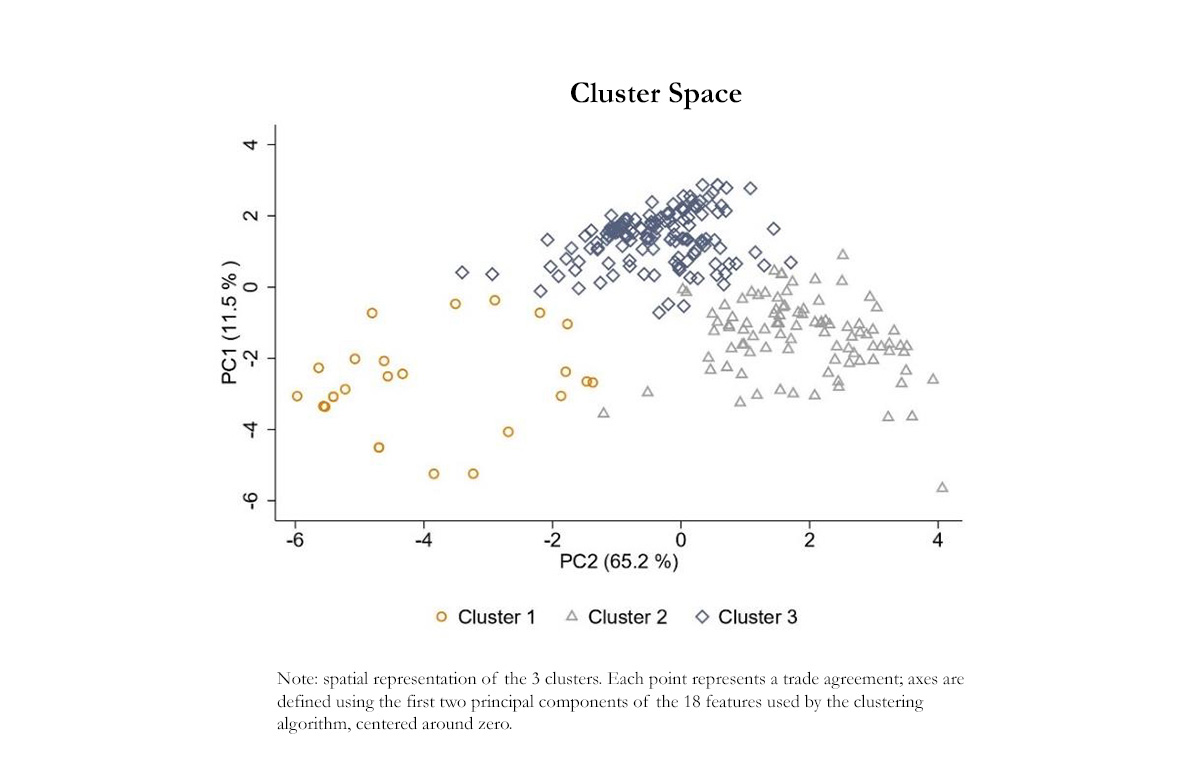
Working Paper Series no. 866: The Economic Impact of Deepening Trade Agreements
This paper explores the economic impacts of preferential trade agreements, conditional on their level of ambition. We cluster 278 agreements, encompassing 910 provisions over 18 policy areas and estimate the trade elasticity for the different clusters. We then use these elasticities in a series of general equilibrium counterfactual situations for endowment economies, revealing that deepening existing agreements (the intensive margin of regional integration) could boost world trade by 5 percent and world GDP by 1 percent. The expected gains from deepening agreements within or across regions vary depending on the initial depth of agreements and the size of regional markets.
Preferential Trade Agreements (PTAs) are increasingly made of complex legal documents covering a large array of border and behind the border policies. Hence, systemic changes in the structure of these PTAS may have more complex effects than captured by the usual approach controlling for the presence (or absence) of a PTA between each country pair in trade equations. In this paper we build on the recent strand of the structural gravity literature and explore the uneven economic impacts deriving from the diverse provisions contained in PTAs –the so-called intensive margin of regional integration.
The first step of the analysis is to define statistically significant groupings of PTAs based on their content. We rely on an exhaustive description of the provisions included in PTAs based on the new World Bank Deep Trade Agreement database. We use information on all policy areas (except tariffs) encompassing objectives, substantive commitments, and enforcement procedures present in legal texts, and available annexes of the 278 PTAs in force and notified to the WTO up to 2018. The high dimensionality of the underlying information requires that we group detailed provisions into categories, assess the ambition of each category in each agreement, and finally group agreements according to similarity in the ambition of the categories of provisions they contain. These agreements notified to the WTO contain 906 provisions, grouped into 18 categories. Using a state-of-the-art classification algorithm, we end up with three groups of PTAs, whereby the distance between observations within each group is minimised and the distance between groups is maximised.
The next task is to estimate the trade impact of each category of PTAs, taking stock of our classification of agreements. Here again, we let the data speak and estimate what is the mean impact of belonging to a PTA positioned in a certain group. We control for the right benchmark in terms of trade cost, namely domestic trade –- meaning that we embark internal trade flows in our estimation of the trade effects of the different types of PTAs. This confirms the accuracy of our classification: the three groups have a statistically different impact on trade, and we name them with the mnemonics “deep”, “medium” and “shallow” according to their decreasing impact on trade. The Figure below represents agreements of the three types in the cluster space.
The last step of the analysis is quantifying the trade and welfare impacts of counterfactual PTAs, having a different ambition. Since we know what the impact of different groups of signed PTAs on trade is, we can assess the economic consequences of deepening existing PTAs. We firstly move all existing PTAs away from their cluster towards the most ambitious one (i.e. “deep”) and examine the effects of such policy reform. Since we are not changing the network of agreements but only their content, this exercise captures a variation in the intensive margin of regional trade integration. We find that deepening all existing trade agreements could boost world trade by 5 percent and world GDP by 1 percent relative to the baseline. Few countries are negatively affected by the deepening of trade cooperation, but overall gains are significantly positive for most of the countries, illustrating the importance of the intensive PTA margin for international trade cooperation. We then simulate the economic impacts of deepening separately the existing agreements within each region and between regions. Results are diverse across the regions of the world economy, given the current ambition of signed PTAs and the different sizes of regional markets. Countries in the East Asia and Pacific region would mostly benefit from deepening preferential trade agreements within the region, while countries in the Middle East and North Africa region would benefit more from deepening agreements with partners outside the region. All other regions fall somewhere between these two extremes. Given the diversity of policy preferences may be larger across than within regions, the low hanging fruits when it comes to deepening trade agreements may be mostly regional. But the gains of these different integration strategies (within or between regions) would ultimately differ across countries.
Download the PDF version of this document

- Published on 02/14/2022
- 33 pages
- EN
- PDF (3.42 MB)
Updated on: 02/14/2022 18:00
